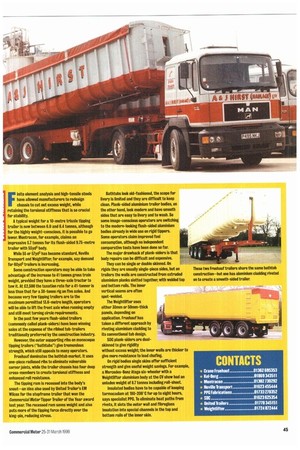F inite element analysis and high-tensile steels have allowed manufacturers to
Page 47

If you've noticed an error in this article please click here to report it so we can fix it.
redesign chassis to cut out excess weight, while retaining the torsional stiffness that is so crucial for stability.
A typical weight for a 10-metre triaxle tipping trailer is now between 6.0 and 6.4 tonnes, although for the highly weight-conscious, it is possible to go lower. Montracon. for example, claims an impressive 5.7 tonnes for its flush-sided 9.75-metre trailer with 55yd3 body.
While 55 or 57yd3 has become standard, Neville Transport and Weightlifter, for example, say demand for 60yd3 trailers is increasing.
Some construction operators may be able to take advantage of the increase to 41 tonnes gross train weight, provided they have a three-axle tractor to tow it. At £2.500 the taxation rate for a 41-tonner is less than that for a 38-tonne rig on five axles. And because very few tipping trailers are to the maximum permitted 13.6-metre length, operators will be able to lift the front axle when running empty and still meet turning circle requirements.
In the past few years flush-sided trailers (commonly called plank-siders) have been winning sales at the expense of the ribbed tub-trailers traditionally preferred by the construction industry.
However, the outer supporting ribs on monocoque tipping trailers ("bathtubs") give tremendous strength, which still appeals to many operators.
Fruehauf dominates the bathtub market. It uses one-piece radiused ribs to eliminate vulnerable corner joints, while the trailer chassis has four deep cross-members to create torsional stiffness and enhanced roll resistance.
The tipping ram is recessed into the body's snout—an idea also used by United Trailer's EM Wilcox for the stepframe trailer that won the Commercial Motor Tipper Trailer of the Year award last year. The recessed ram saves weight and also puts more of the tipping force directly over the king-pin, reducing stress.
Bathtubs look old-fashioned, the scope for livery is limited and they are difficult to keep clean. Plank-sided aluminium trailer bodies, on the other hand, look modern and have smooth sides that are easy to livery and to wash. So some image-conscious operators are switching to the modern-looking flush-sided aluminium bodies already in wide use on rigid tippers. Some operators claim improved fuel consumption, although no independent comparative tests have been done so far.
The major drawback of plank-siders is that body repairs can be difficult and expensive.
They can be single or double skinned. On rigids they are usually single-piece sides, but on trailers the walls are constructed from extruded aluminium planks slotted together, with welded top and bottom rails. The inner vertical seams are often spot-welded.
The Weightlifter uses either 30mm or 50mm-thick panels, depending on application. Fruehauf has taken a different approach by riveting aluminium cladding to its conventional tub design.
SDC plan k-siders are dualskinned to give rigidity without excess weight; the inner walls are thicker to give more resistance to load chafing.
On rigid bodies single skins offer sufficient strength and give useful weight savings. For example, a Mercedes-Benz Atego six-wheeler with a Weightlifter aluminium body at the CV show had an unladen weight of 8.7 tonnes including roll-sheet.
Insulated bodies have to be capable of keeping tarmacadam at 180-200C for up to eight hours, says specialist PPG. To eliminate heat paths from rivets, it slots the outer wall and fibreglass insulation into special channels in the top and bottom rails of the inner skin.
















































































































